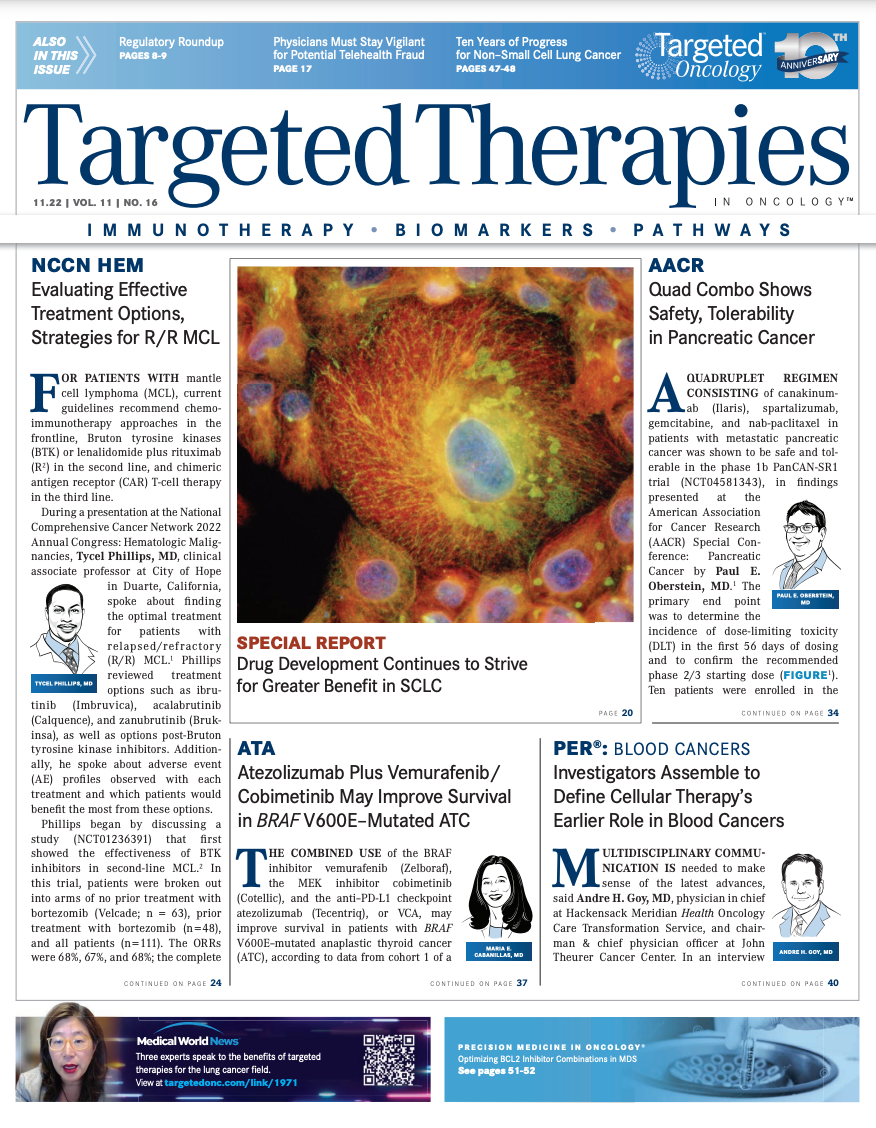Novel Agent Shows Tolerability and Response Signals in Combination With Chemotherapy in mPDAC
There was a potential antitumor signal observed with NGM120 in combination with chemotherapy, according to Andrew E. Hendifar, MD.
Andrew E. Hendifar, MD

NGM120, a first-in-class anti-glial-cellderived neurotrophic factor (GDNF) family receptor alpha–like (GFRAL) antibody, demonstrated tolerability and potential antitumor activity when used in combination with gemcitabine and nab-paclitaxel (Abraxane) in a cohort of patients with metastatic pancreatic ductal adenocarcinoma (mPDAC), according to initial findings from a phase 1b trial.1
"There was a potential [antitumor] signal in combination with chemotherapy that was based on the response criteria,” Andrew E. Hendifar, MD, associate professor of medicine and medical director of the Pancreatic Cancer Program at the Cedars-Sinai Samuel Oschin Cancer Center, said at the AACR Special Conference on Pancreatic Cancer.
Hendifar explained that GDF15 is a growth factor involved in the regulation of appetite, metabolism, and immune function. When elevated, GDF15 can be associated with pathophysiological states like cancer. GFRAL is a GDF15 receptor.
Specifically, high GDF15 levels are more often found in patients with pancreatic cancer than in healthy individuals (P < .0001) and are associated with shorter survival in a number of cancer types.
NGM120 was designed to bind to GFRAL. Hendifar noted that it has a very high binding affinity (785 fM) and decreases GDF15 signaling. Preclinical data for NGM120 have shown that the agent was able to reduce tumor growth and improve survival in syngeneic orthotopic pancreatic tumor models and improve the antitumor activity of PD-1 inhibition in mice.
Hendifar presented the results of a small phase 1b study of patients with mPDAC who received NGM120 plus gemcitabine and nab-paclitaxel.
Inclusion criteria required patients to have not received any prior chemotherapy unless with neoadjuvant or adjuvant intent and to have serum GDF15 level above 1300 ng/mL. Patients received either 30 mg (n = 4) or 100 mg (n = 4) of NGM120 plus 1000 mg/m2 gemcitabine and 125 mg/m2 nab-paclitaxel every 3 weeks.
The study’s primary end point was maximum tolerated dose or maximum feasible dose, which was determined by dose-limiting toxicities, adverse events (AEs), and serious AEs. Additional end points included serum concentration of NGM120, pharmacokinetic parameters, tumor changes, CA19-9 level changes, and body weight changes.
Patients had a median age of 67 years (range, 51.5-73.9) and the majority were women with stage IV disease and only 1 metastatic site. Half the patients had metastatic disease in the liver. The median time from initial cancer diagnosis was 0.666 years (range, 0.1-3.5).
Six of 8 patients had at least 1 follow-up evaluation. Two developed an unrelated serious AE and were discontinued from treatment before they could be evaluated.
Of the 4 patients who received the 30-mg dose, 3 discontinued treatments (at between 40 and 74 weeks): 2 due to stable disease and 1 due to a partial response (PR) that was read as progressive disease by local read. One patient in the 30-mg group, who had the lowest level of GDF15, was still receiving therapy after about 90 weeks and had a PR to treatment. In the 100-mg group, 1 patient had stable disease and discontinued and the other had a PR to treatment but discontinued owing to a serious AE unrelated to treatment.
No dose-limiting toxicities were reported, and no treatment-emergent AEs (TEAEs) were specifi cally attributed to NGM120.
Safety and Outcomes
TEAEs of grade 3 or higher that occurredin more than 1 patient included platelet decrease, hypertension, diarrhea, peripheral sensory neuropathy, and fatigue. One grade 5 event (cardiac arrest) was reported.
The median progression-free survival (PFS) was not reached in either the overall group or the 6 evaluable patients. At 12 months, the PFS rate was 71.4% (95% CI, 25.8%-92.0%) in all 8 patients and 83.3% (95% CI, 27.3%-97.5%) in the 6 evaluable patients. By comparison, the 12-month PFS rates with gemcitabine and nab-paclitaxel alone are between 35% and 48% in mPDAC.
The disease control rate was 75% in the overall group and 100% in the evaluable population. The objective response rate was 37.5% in the overall group and 50% in evaluable patients. With the standard gemcitabine/ nab-paclitaxel combination, reported disease control rates are between 50% and 76% and objective response rates are between 23% and 43%.
With regard to percentage difference in tumor size by RECIST 1.1 criteria, “you can see quite signifi cant responses in quite a few patients, and notably they are durable,” Hendifar said, adding that “some of them are quite steep.” These patterns of response were similar in terms of serum CA19-9 concentrations after treatment with the triplet regimen.
“Generally, in patients with advanced pancreas cancer, they tend to lose weight throughout the disease course…so in that sense, this is a significant finding and something we’re really excited about,” Hendifar pointed out.
NGM120 is also being investigated in a phase 2a trial with or without gemcitabine and nab-paclitaxel in patients with mPDAC treated in the fi rst-line setting (PINNACLES; NCT04068896). Enrollment for this study has already been completed.
REFERENCES:
1. Hendifar A, Dotan E, Weinberg B, et al. Initial results of a cohort of advanced pancreatic cancer patients in a phase 1b study of NGM120, a first-in-class anti-GDNF Family Receptor Alpha Like (GFRAL) antibody.Paper presented at: 8th AACR Special Conference on Pancreatic Cancer; September 13-16, 2022; Boston, MA.
